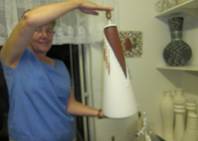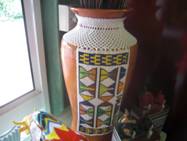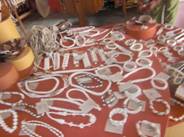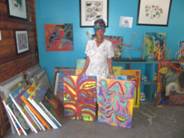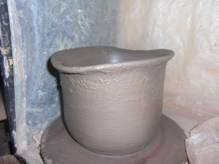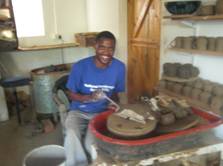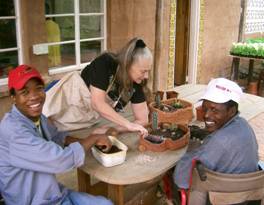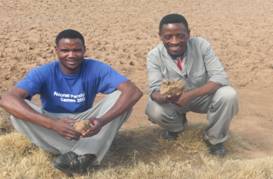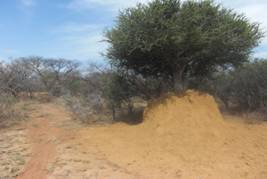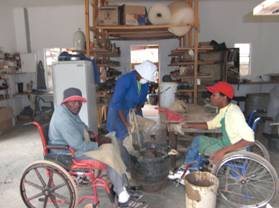In 2005 I took up a post, advertised in Ceramic Review, to work in Botswana, with John Mutale, a potter from Zambia. After only 5 weeks I had to return home urgently as my eldest son was involved in a serious accident. It was not until November 2008 that I was able to return to fulfill my obligation.
Namune Pottery is part of MostseWa Badiri, or village community, it is the training centre for adults with disabilities, run by Camphill trust. The pottery had been well set up by Peter Hawes before he left, with an electric kiln and a wonderful waste oil kiln. There are 4 disabled and 2 able bodied workers plus John Mutale, lecturer and head of ceramics department in Zambia before it closed.
So why was I there? POTTERY as a BUSINESS. bI try to improve the quality of work produced, helping to make it more marketable, and look for new outlets. I don’t usually show new methods, but stay well within the traditions of the country I am in. Namune pottery was different; it was already in the world. John had found clay locally, a mix of Ant hill and River bed clays, so saved the cost of imports. We used pulp from Ant Hill Claya papermaking project for the paper clay. It was amazing, better then any clay I have ever seen.
Some of the work I did was thanks to South Wales Potters workshops
Burnishing. Smoking. (Christine Gittens)
Thick slip decorating, Paper clay, mending, Making good. With on glaze painting. (Joanna Howells)
Movement in animals. (Ian Gregory)
Use of glass, Dropped dishes. (Jack Doherty)
Raku ( Mick Morgan 20 years ago )
Angels and Cactus gardens with those who were not ready for other work, Lots more, Teaching English as we went.
Ngongorego, now trained potter, and supervisor loves his job. He lost his feet in a fire as a baby.
We worked very well from 8am to 5pm, five days a week, taking one hour for lunch, even though the temperature was between 34 and 40 degrees Celsius.
I was so grateful to Dr Zulu; a friend of John’s who lent me a car so I didn’t have to walk for 20 minutes to work in all that heat.
Toni Heili, new in Botswana from Zimbabwe, came to the workshop, and commissioned small pottery sacks for herbs, she’s starting a business with the herb pots; John used Joanna Howells’ thick suspended slip, to make the Hessian look, the tops of the thrown pots were squeezed together, holes were made for string and labels.
Toni and I, both business women were immediately friends. “Would you like to go to Ghanzi, an 8 hour drive, to the Bushmen or Sam people” so off we went.
Toni Heili does the most incredible bead work on pots, and is interested in Tribal bead work. She hopes to hold an exhibition with John Mutale in Britain, in a few years time.
Feb 2009 demonstrations of Microwave kilns in Johannesburg, then return to Botswana, this time to introduce a Business course, and do some more Raku. As for the future, I have been invited to return to Zambia, and also to work in Lesotho. Since my degree in 2000, along side my own work I’ve worked in Albania, Zambia, and Botswana, I have felt privileged to have had the opportunity to give back some of the knowledge I have received in helping to re-establish pottery skills, and make pottery a realistic possibility for income generation. All is voluntary, sometimes I have had my air fare or board and lodge, but Pottery is my passport to new lands and new friends.

